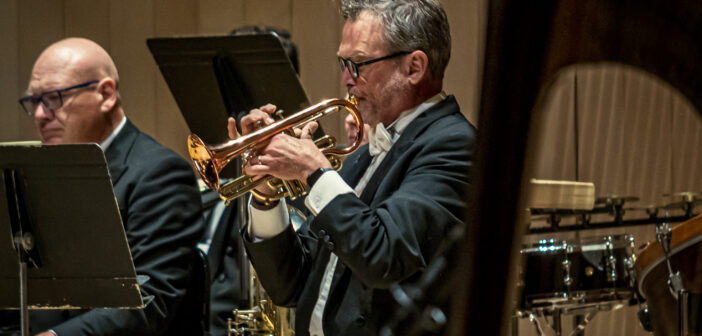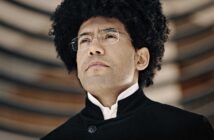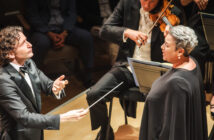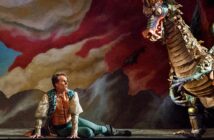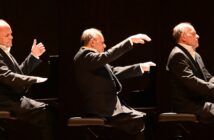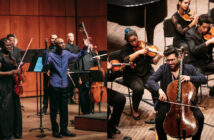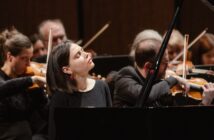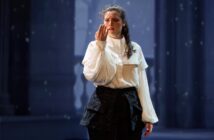It is not often that the Toronto Symphony Orchestra (TSO) features a soloist from Iceland, nor does it frequently play music by Icelandic composers. Yet this week we had both – on the same program. Not only that, the TSO gave us a new piece by a Metis composer. But wait, there’s more. Super Mozart and spectacular Berlioz. In short, a great concert.
The TSO is currently celebrating its 100th anniversary, and someone came up with the brilliant idea of commissioning 10 Toronto composers to write short pieces to draw attention to it. The first of the Celebration Preludes was played last April and Des(re)pair, the final work in the set was played this week. Eliot Britton is a member of the Manitoba Metis Federation and is cross appointed between Music Technology & Digital Media and Composition at the University of Toronto’s Faculty of Music. He tells us in a program note that his new piece was inspired by despair and the difficulty of making music out of dark places. It is an agonizing process, he says, and he is still “working on it.” Des(re)pair is mostly bright and bouncy but it does end with a whimper. Good luck to Dr. Britton as he battles his demons. I doubt that he could have had better advocates than Gimeno and the TSO.
Next up was another world premiere, Icelandic composer Daniel Bjarnason’s I Want to Be Alive -Trilogy for Orchestra First Part: Echo/Narcissus. The work was commissioned by the TSO along with three other orchestras. In a future season the TSO will perform the complete trilogy. Before this week’s premiere of the first part conductor Gustavo Gimeno made some introductory comments from the podium. They were superfluous, adding nothing to what was in the program notes. The composer’s own introductory comments, also included in the program, were not much help either. The problem is that Bjarnason seems to be trying to express philosophical ideas in music, and that by its very nature is almost impossible. One can point to Richard Strauss’ attempt to translate Nietzsche’s Also Sprach Zarathustra into music. But in that case, what Strauss is really doing is painting pictures while leaving the ‘philosophy’ to the philosophers. Bjarnason should do the same. He talks about drawing inspiration from “different questions about the nature of consciousness” and makes a currently fashionable reference to AI and its ethical implications but in the end music is essentially incapable of expressing much more than itself. On the other hand, adding suggestive titles and texts can move the process along. In the case of I Want to Be Alive the composer does direct our attention to the Echo and Narcissus story as a way of characterizing “the fundamental human desire for autonomy and self-determination.” By that as it may, music has a hard time telling the Echo and Narcissus story too.
But Bjarnason is certainly a talented composer. His new piece is full of striking orchestral effects. Whether there is more than that in the new piece is not easy to determine after only one hearing. I do wonder, however, about at least one aspect of his orchestration. Bjarnason has written a piece for a very large orchestra including an electric guitar. I saw this musician strumming from time to time, and at one point in the score he even used what looked like a violin bow. But I can’t say that I heard even one note that he played. Perhaps he was playing a phantom guitar part that was not meant to be heard at all.
For the record, both Eliot Britton and Daniel Bjarnason were on hand to hear their works performed and both men came to the stage to acknowledge warm applause.
Vikingur Olafsson is a 39-year-old Icelandic pianist who has become a media star in recent years for his themed CDs and videos on Deutsche Grammophon featuring mostly tuneful and atmospheric music by Bach, Mozart, Rameau and several others. It would be easy to dismiss him as a popularizer. But he happens to be a fine pianist and unquestionably a serious artist. He made his TSO debut in 2018 as soloist in Daniel Bjarason’s challenging Piano Concerto and he was back this week playing Mozart’s Piano Concerto No. 24 in C minor K. 491. This concerto is one of Mozart’s most dramatic and forward-looking works, foreshadowing Beethoven’s own piano concerto in c minor written about 14 years later. Vikingur approached Mozart’s concerto in a Beethovenian manner with strong accents and frequent changes of tempo. But it all made sense. When Vikingur slowed down appreciably for the development section in the first movement it was an entirely convincing change of pace. And in the 6/8 section at the end of the third movement, the slower tempo very effectively brought out the melancholy inherent in the music. Vikingur played his own cadenzas for this concerto – as he does in his YouTube performance with Paavo Järvi conducting – and while modestly conceived did the job very well. Gimeno and the TSO proved to be exemplary colleagues. This concerto abounds in beautiful solo writing for flute, oboe, clarinet and bassoon and piano soloist and winds played off each other to perfection. Kudos to the two horns as well for dovetailing wonderfully well as required.
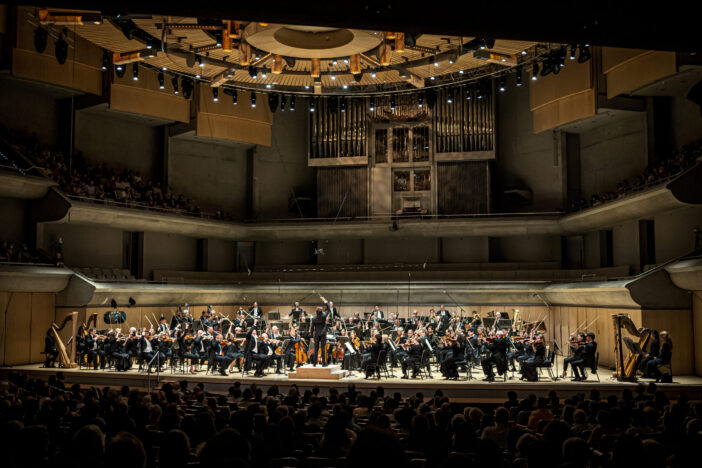
Photo: Allan Cabral
I have fond memories of Seji Ozawa conducting Berlioz’ Symphonie Fantastique with the TSO back in the 1960s. This was one of the young Ozawa’s party pieces and he brought a unique poetry and excitement to the work. But that was a long time ago and the TSO has played the Symphonie Fantastique dozens of times since. Yet this week at Roy Thomson under their current maestro Gustavo Gimeno the TSO gave a performance just about as good as any I have ever heard. Perhaps it didn’t offer the Dionysian abandon of a performance conducted by Charles Munch but on its own terms it was stunning. And for good measure it offered a version seldom heard in the concert hall: the version featuring a cornet solo in the second movement.
It was Berlioz himself who added this solo, apparently for the cornet virtuoso Jean-Baptiste Arban (1825-1899). The cornet was invented around 1825 and the Symphonie Fantastique was composed in 1830. Berlioz was one of the all-time great orchestrators and was always interested in creating new orchestral effects and was always on the lookout for new instruments. In the 1820s one of the standard brass instruments in a symphony orchestra was the trumpet. But at this time trumpets had no valves and were limited as to what notes they could play. Enter the cornet. It was a valved instrument capable of playing just about any kind of melodic pattern a composer might want, and in the trumpet range. To hedge his bets Berlioz asked for two trumpets and two cornets in the Symphonie Fantastique. He didn’t particularly like the sound of the cornet but he did like its flexibility. In the March to the Scaffold, for example, it is the cornets that play the whole melody while the trumpets just play what they can.
The cornet solo Berlioz added in the second movement adds some colour and brilliance without radically altering the original version much at all. But Gimeno obviously loves this added touch and brought it to our attention by having the soloist step away from his usual chair in the brass section and move forward to a different position and playing standing up. Needless to say, principal trumpet Andrew McCandless played the cornet solo with his usual virtuosity. Actually, he used two different cornets for his solo.
Gimeno also did something else that added to the success of the second movement waltz. There are parts for two harps – no harps required elsewhere in the symphony, by the way – but Gimeno decided to use four, two on either side of the stage at the front. The idea was to give the harps a better chance to be heard. And it worked. Incidentally, I remember seeing four harps used in a video of the work by the Berlin Philharmonic conducted by Claudio Abbado in 2013.
In the third movement Berlioz has written a dialogue between two shepherds, some distance away from each other. In this performance, one shepherd was represented by the English horn in the orchestra, and the other by an oboe in the balcony. But from my seat in the Mezzanine I had little sense of distancing between the two instruments. Perhaps next time Gimeno might try placing the oboe somewhere else in the hall, or offstage. Bells are prominent in the last movement and they were indeed offstage. But again, for some reason, they did not sound distant at all.
On the whole, however, this was an excellent performance and demonstrated yet again that in the TSO we have a wonderful orchestra. The bite and polish, and beauty of tone in the brass section should be a model for orchestras everywhere. The wind section abounds in world-class soloists and the strings led by concertmaster Jonathan Crow are refined and flexible. And with Gustavo Gimeno on the podium the TSO has a conductor who knows what he wants and has the technique and imagination to get it.
- Toronto Symphony Orchestra, Gustavo Gimeno, conductor
- Vikingur Olafsson, piano
- Roy Thomson Hall, Toronto
- Tags: Toronto Symphony Orchestra, Gustavo Gimeno, Vikingur Olafsson, Roy Thomson Hall, Toronto
- June 7, 2023
- www.tso.ca

